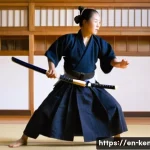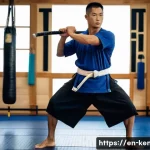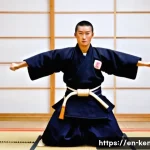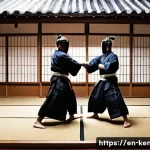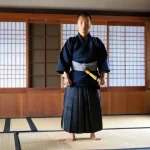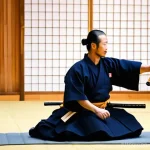Stepping into a local Kendo equipment shop is an experience unlike simply adding an item to a cart online. There’s a certain weight to a high-quality shinai, a distinct texture to a finely woven kendogi, and a profound sense of craftsmanship you can only truly appreciate firsthand.
As a practitioner for years, I’ve always found that the nuanced fit of a men or the precise balance of a bokken isn’t just about comfort; it’s intrinsically linked to safety and performance, insights that simply don’t translate through a screen.
In an age where AI-driven recommendations flood our feeds and everything seems optimized for speed, the value of hands-on experience and personalized guidance at a brick-and-mortar Kendo store is more crucial than ever.
These specialized shops aren’t just retail spaces; they’re often vital community pillars, where seasoned practitioners share invaluable wisdom and beginners forge their initial, tangible connection to the art.
This tactile engagement helps combat common online pitfalls like ill-fitting gear leading to costly returns and unnecessary waste, aligning perfectly with a growing global awareness for sustainable consumption.
Moreover, as customized and high-performance gear continues to be a major trend, the expert fitting and personalized advice found offline remain absolutely irreplaceable for serious kendoka.
Let’s dive deeper into it below.
The Irreplaceable Value of Hands-On Fitting and Expert Guidance
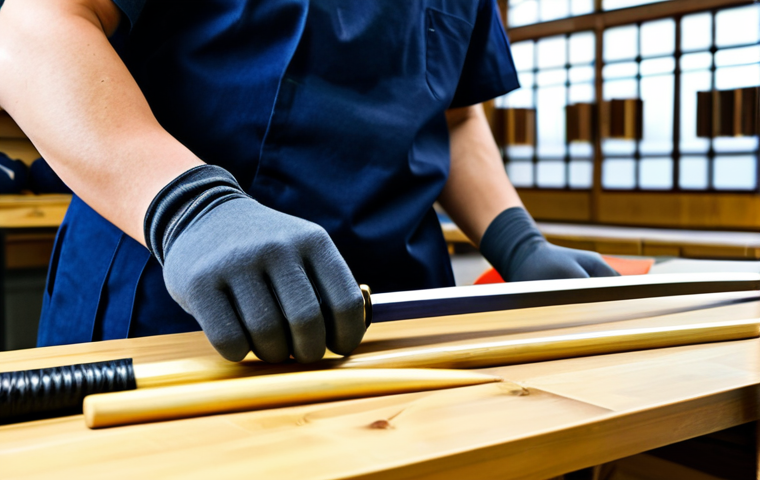
There’s a profound difference between clicking through size charts on a website and actually having an experienced practitioner, someone who has spent decades in the dojo themselves, guide you through the process of selecting a men or a kote. I still remember my very first men – I bought it online, thinking “a size is a size.” Oh, how wrong I was! The fit was off, not just a little snug, but fundamentally incorrect for my head shape, leading to discomfort during keiko and a feeling of being constantly distracted rather than focused on my technique. It was a costly mistake, both in terms of money and precious training time. A local shop, on the other hand, provides that critical personal touch. They understand the nuances of different manufacturers’ sizing, the variations in head shapes and hand sizes, and how the gear needs to move with your body, not against it. This isn’t just about comfort; it’s about safety and performance. An ill-fitting men can impair your vision or cause painful pressure points, while poorly sized kote can restrict wrist movement, hindering your strikes and leaving you vulnerable. The expertise found in these shops goes beyond simple measurements; it delves into the functional aspects of the gear under the duress of actual training. They can observe your posture, recommend adjustments, and even suggest specific models that might suit your individual kendo style or physical build, something a static product description can never achieve. It’s truly an investment in your training journey, ensuring every piece of equipment serves its purpose optimally and allows you to focus purely on the art itself, rather than wrestling with uncomfortable gear.
1. Personalized Sizing and Customization Opportunities
- When you step into a dedicated Kendo store, you’re not just buying off the rack; you’re often getting a bespoke experience. I’ve seen countless beginners walk in with preconceived notions about what they need, only to leave with something entirely different, and perfectly suited. Imagine trying on a men that feels like a natural extension of your body, rather than a cumbersome helmet. The shop owner, with their seasoned eye, can spot subtle misalignments or suggest padding adjustments that make all the difference during a long, intense keiko session. They understand that every kendoka’s body is unique, and what works for one person might be entirely unsuitable for another. This level of personalized fitting often extends to customization, whether it’s specific embroidery on your bogu bag, or tailoring a kendogi to your exact sleeve length, ensuring it doesn’t bunch up or restrict movement. It’s about achieving that elusive “perfect fit” that boosts confidence and enhances performance.
- Beyond the initial fit, these experts can advise on the longevity and maintenance of customized gear. For instance, a well-fitted men allows for proper airflow, reducing sweat accumulation and extending the life of the internal padding. They can tell you about specific materials that might wear differently based on your training intensity or climate, and offer solutions like bespoke repair services for high-wear areas on your bogu. This level of tailored attention is simply impossible to replicate with online purchases, where you rely solely on generic size charts and user reviews, often leading to compromises in comfort and, ultimately, performance.
Tangible Quality and Craftsmanship Assessment
Holding a high-quality shinai or feeling the texture of a premium kendogi in your hands is an experience that transcends mere visual information. Online, every product image is polished, every description touts “superior craftsmanship.” But how often have you received an item only to find the material feels cheap, the stitching looks flimsy, or the balance is just… off? I’ve been there too many times, ordering a shinai that looked perfect online, only to find it felt dead in my hands, lacking the vibrant, responsive feel essential for good kendo. In a physical store, you can examine the bamboo staves of a shinai for perfect grain alignment, ensuring durability and a true strike. You can test the flexibility and balance, feeling how it sits in your grip. For bogu, you can scrutinize the stitching on the kote, checking for tight, even lines that indicate resilience against countless strikes. You can feel the density and resilience of the padding in the men and do, understanding how well it will absorb impact. This tactile engagement isn’t just about aesthetics; it’s about verifying the functional integrity and longevity of your investment. It allows you to develop an instinctive sense for what “good quality” truly feels like, a skill that is invaluable as you progress in kendo and begin to discern the subtle differences between various levels of equipment.
1. Inspecting Material Quality and Durability
- One of the biggest advantages of shopping in person is the ability to physically inspect the materials. For instance, with a kendogi, you can feel the weave of the fabric – is it too stiff? Does it feel durable enough to withstand the rigors of intense training sessions, or will it quickly wear thin? You can look for evenness in the dye, ensuring it won’t bleed onto your skin or other garments. Similarly, when examining a bogu set, you can assess the quality of the indigo dye, the thickness and resilience of the deerskin or synthetic leather, and the overall construction. I once saw a beginner buy a budget bogu online, and within a few months, the stitching on the kote had completely frayed, rendering them unusable. Had they been able to inspect it in person, they would have immediately noticed the loose stitching and thin material that foreshadowed its short lifespan.
- This tactile inspection extends to the smallest details that impact long-term use. Are the internal ties on the men securely fastened? Is the do-mune (chest protector) made from a material that will retain its shape and offer adequate protection? These are questions best answered by your own hands and eyes, not by a pixelated image on a screen.
2. Assessing Balance and Ergonomics of Shinai and Bokken
- The balance of a shinai or bokken is incredibly personal and crucial for effective training. What feels “balanced” to one kendoka might feel “heavy-tipped” to another. In a physical shop, you can pick up various shinais, test their weight distribution, and feel how they move through the air when you perform suburi. You can experiment with different tsuba (hand guard) and tsuba-dome (stopper) combinations to find the perfect grip and weight distribution that complements your unique cutting style. This hands-on testing is vital because the subtle variations in balance can significantly impact your speed, power, and precision during practice.
- For bokken, the ergonomics are equally important. You can assess the grip, the contour of the handle, and how it feels in your hands for various kata. Some practitioners prefer a thicker handle for better grip, while others opt for a slimmer profile for faster transitions. These are highly subjective preferences that cannot be conveyed through specifications alone. My sensei always emphasizes that the bokken should feel like a natural extension of your arm, and only by holding and swinging several can you find that perfect match.
Building Community and Networking Opportunities
Beyond the transactional aspect of buying gear, local Kendo shops often serve as vital community hubs, fostering connections that enrich your journey in the art. I’ve spent countless hours in my local shop, not just browsing, but chatting with the owner, who is a high-ranking sensei themselves, and other kendoka who happen to drop by. These conversations are invaluable. I’ve received tips on training, advice on specific techniques, and even invitations to practice at different dojos. It’s a place where knowledge is freely exchanged, and mentorship happens organically. Unlike the impersonal nature of online forums or social media groups, where interactions are often fleeting and superficial, a physical shop provides a tangible space for deeper, more meaningful connections. You meet fellow practitioners from your area, share experiences, and build friendships that extend beyond the dojo floor. This sense of belonging is crucial for motivation and long-term engagement in a demanding martial art like Kendo. It’s about more than just equipment; it’s about nurturing the spirit of community that is so central to traditional Japanese martial arts. This invaluable aspect truly sets the offline experience apart, transforming a simple purchase into an opportunity for growth and camaraderie, which contributes significantly to retention in the art.
1. Access to Experienced Practitioners and Mentorship
- Many local Kendo shop owners are not just retailers; they are seasoned kendoka themselves, often with decades of experience and deep connections within the Kendo community. Their advice is gold. They can offer insights into different training methodologies, recommend dojos, or even provide guidance on your personal progression. I remember struggling with a particular waza, and the shop owner, after hearing me describe my issue, spent twenty minutes explaining a subtle body movement that completely changed my approach. This kind of spontaneous, personalized mentorship is simply not available when you’re just clicking “add to cart.” They often know the history of different equipment makers, the pros and cons of various materials based on real-world use, and even local dojo dynamics, providing a holistic perspective that enriches your understanding and practice.
- This mentorship extends to younger practitioners as well, as they can ask questions in a relaxed environment about everything from bogu care to preparing for their first grading. It fosters a sense of continuity and tradition, ensuring that valuable knowledge is passed down through generations, unmediated by algorithms.
2. Discovering Local Kendo Events and Opportunities
- Local shops are often the central hub for information about regional Kendo events. Tournaments, seminars, workshops, and even open practices at other dojos are frequently advertised or discussed within these spaces. You might stumble upon a flyer for a visiting sensei’s seminar or hear about a local taikai that you wouldn’t have known about otherwise. This is incredibly valuable for expanding your Kendo network and gaining new experiences. I’ve found out about several high-quality training camps simply by striking up a conversation with someone else browsing the shop’s selection of shinai.
- These shops can also facilitate connections for group orders or bulk purchases for dojos, often providing discounts or special services. They understand the local Kendo ecosystem and act as an unofficial bulletin board, connecting practitioners with vital opportunities that help them grow and stay active within the broader Kendo community.
Immediate Availability and On-Site Services
There’s a certain peace of mind that comes with walking into a store, picking out exactly what you need, and walking out with it immediately. No waiting for shipping, no worrying about lost packages, and certainly no agonizing over return processes if something isn’t right. This immediate gratification is particularly crucial for items like shinai, which break frequently during intense practice. When your main shinai splits mid-practice, waiting three to five business days for a replacement from an online retailer can be a significant disruption to your training schedule. A local shop means you can get back on the dojo floor almost instantly. Beyond just immediate purchase, many specialized Kendo shops offer on-site services that are simply unavailable online. This includes things like re-stringing a tsuka (shinai handle), performing minor repairs on bogu components, or adjusting the balance of a shinai. These services extend the life of your expensive equipment and ensure it remains in optimal condition, saving you money in the long run and preventing potential injuries from poorly maintained gear. It’s not just about buying; it’s about comprehensive support for your equipment over its entire lifecycle, a benefit that online vendors cannot possibly replicate without significant logistical hurdles for the customer.
1. Resolving Urgent Equipment Needs
- Anyone who practices Kendo regularly knows the sudden panic of a broken shinai or a snapped bogu string right before an important practice or shiai. This is where the local shop becomes an absolute lifesaver. Instead of being sidelined for days or weeks while you wait for a shipment, you can simply pop down to your local store and pick up a replacement or get a quick repair. This instant solution is indispensable for maintaining consistency in your training and avoiding unnecessary interruptions. I’ve personally had moments where a faulty shinai meant missing a crucial part of a training camp, simply because I relied on online orders. That’s a frustration you just don’t experience with a well-stocked local store.
- Moreover, if you discover an issue with newly purchased gear – a loose stitch, a misaligned part – you can simply walk back to the store and resolve it face-to-face, avoiding the often tedious and time-consuming process of online returns and exchanges, which can involve shipping costs and lengthy processing times.
2. Essential On-Site Maintenance and Repair Services
- The lifespan of Kendo equipment can be significantly extended with proper maintenance and timely repairs. A local shop often provides essential services like re-stringing shinai, replacing worn out tsukagawa (handle leather) or sakigawa (tip leather), and even minor bogu repairs such as stitching up a tear in kote or replacing damaged strings on the do. These services are performed by individuals who understand the specific needs of Kendo equipment, ensuring the repairs are done correctly and safely.
- They can also provide valuable advice on ongoing care, such as how to properly dry your bogu after practice to prevent mildew, or how to maintain the leather on your kote to prevent cracking. This comprehensive support ensures your gear remains safe and functional for longer, protecting your investment and your body during practice.
Economic and Environmental Sustainability
While online shopping often touts convenience and competitive pricing, the hidden costs, both economic and environmental, often go overlooked. Think about the carbon footprint of shipping gear across continents, the amount of packaging waste generated, and the energy consumed by massive fulfillment centers. Now, consider the impact of frequent returns due to ill-fitting or misrepresented items; each return trip adds to the environmental burden and logistical complexity. In contrast, supporting a local Kendo shop contributes directly to your community’s economy. Your money stays local, helping to sustain small businesses, create jobs, and keep specialized expertise alive. Moreover, by purchasing gear that fits correctly and is of verified quality, you significantly reduce the likelihood of returns and premature replacements, thereby minimizing waste. This aligns perfectly with a growing global awareness for sustainable consumption and ethical purchasing. It’s a conscious choice to invest in quality, longevity, and community, rather than succumbing to the throwaway culture often encouraged by fast online retail. When you buy locally, you’re not just acquiring gear; you’re investing in a more sustainable future for both your practice and the planet, ensuring that the resources and energy used to create these unique items are maximized.
1. Reducing Returns and Waste through Proper Fit
- One of the most frustrating aspects of online shopping for specialized gear like Kendo equipment is the high rate of returns due to incorrect sizing or quality perception. I’ve seen countless posts in online forums where practitioners complain about ordering a men that simply doesn’t fit, or kote that are too stiff. Each return shipment contributes to carbon emissions and generates packaging waste. By trying on gear in person at a local shop, you drastically reduce the chance of needing to return an item, directly contributing to less waste and a smaller carbon footprint. This immediate feedback loop ensures that what you buy is truly what you need, minimizing the environmental cost associated with trial-and-error purchasing.
- This also applies to the longevity of the equipment. A properly fitted piece of bogu is less likely to wear out prematurely due to undue stress from an improper fit, further reducing the need for replacements and contributing to sustainability.
2. Supporting Local Businesses and Specialized Expertise
- Every purchase made at a local Kendo shop is an investment in the survival of a specialized business that provides unique value to the Kendo community. These shops are often passionate small businesses run by fellow practitioners who have dedicated their lives to the art. They rely on local support to keep their doors open, preserving jobs and ensuring that future generations of kendoka have access to high-quality gear and expert advice. Without them, the Kendo supply chain could become dominated by large, impersonal online retailers who lack the specialized knowledge and community connection.
- Moreover, these shops often serve as training grounds for new repair technicians or aspiring entrepreneurs within the Kendo world, contributing to the growth of specialized skills that are vital for the continued practice and evolution of the art. Your direct support helps maintain this invaluable ecosystem.
Understanding Maintenance and Care Practices
Acquiring Kendo equipment is just the first step; proper maintenance and care are crucial for extending its lifespan, ensuring hygiene, and maintaining its protective qualities. This is an area where local shops shine, offering advice and demonstrations that are simply unavailable through online purchases. I’ve learned invaluable tips from my local shop owner about everything from how to properly dry my men after a sweaty practice to prevent mildew, to the best way to store my shinai to maintain its balance. They can explain the specific care requirements for different materials – how to treat the leather on your kote, or how to wash your kendogi without damaging the indigo dye. This practical knowledge is often passed down verbally, based on years of experience with the equipment in real training conditions. Without this guidance, it’s easy to make mistakes that shorten the life of your expensive gear, leading to costly replacements and potential health issues from unhygienic equipment. It’s about empowering you with the knowledge to be a responsible and diligent kendoka, ensuring your equipment not only lasts but also performs optimally for every keiko. This holistic support makes the investment in local shopping truly worthwhile.
1. Practical Advice on Equipment Longevity
- The advice you get in a local shop about equipment care is often derived from decades of practical experience. They can tell you, based on actual usage scenarios, what practices extend the life of your equipment and what habits shorten it. For example, they might advise against leaving your bogu in a sealed bag after practice to prevent mold and mildew, or suggest specific cleaners for your men’s padding. These aren’t just generic tips; they are tailored to the realities of Kendo training. I remember being told to always dry my bogu in a well-ventilated area, away from direct sunlight, a simple tip that has saved me from replacing moldy padding multiple times.
- They can also provide insights into common wear and tear points, advising you on proactive measures to reinforce those areas or how to spot early signs of damage that can be easily repaired before they become major issues. This preventative approach to maintenance saves you significant money in the long run.
2. Hygiene and Safety Best Practices
- Maintaining hygiene in Kendo equipment is not just about cleanliness; it’s a critical safety factor. Sweaty, uncleaned gear can become a breeding ground for bacteria and fungi, leading to skin infections and unpleasant odors. Local shops can guide you on the best practices for cleaning and sanitizing your equipment, recommending specific products or methods suitable for the delicate materials used in bogu. They understand the nuances of indigo-dyed cotton versus synthetic materials and can advise accordingly.
- Beyond hygiene, they can also educate you on safety checks for your equipment. For instance, regularly inspecting your shinai for splinters or cracks is paramount to prevent injury to yourself or your training partners. They can demonstrate how to properly assemble and disassemble your shinai, ensuring all parts are secure before each practice. This hands-on guidance on hygiene and safety is invaluable, protecting both your health and your training partners.
| Feature | Online Purchase Experience | Local Kendo Shop Experience |
|---|---|---|
| Fitting & Customization | Generic size charts, limited ability to assess fit. Returns are common. | Personalized fitting by experts, on-the-spot adjustments, bespoke options. |
| Quality Assessment | Relies on images and descriptions, risk of receiving lower quality than expected. | Tactile inspection of materials, craftsmanship, and balance before purchase. |
| Expert Advice & Community | Limited to online forums/reviews, impersonal interactions, lack of mentorship. | Direct access to experienced practitioners, mentorship, local event information, community building. |
| Immediate Needs & Repairs | Shipping delays, no instant replacement, complex return processes, no on-site repairs. | Instant purchase, immediate replacements for broken gear, on-site repairs and maintenance services. |
| Environmental Impact | Higher carbon footprint from shipping, increased waste from packaging and returns. | Reduced shipping and returns, supporting local economy, lower overall waste. |
| Maintenance Guidance | Generic online articles, lack of personalized care instructions. | Hands-on demonstrations, tailored advice for specific gear, hygiene best practices. |
Navigating Specialized Selection and Accessories
The world of Kendo equipment is far more diverse and nuanced than what a typical online store might present. Beyond the basic bogu set and shinai, there are countless specialized accessories, training aids, and variations of standard gear that cater to different training styles, preferences, or levels of expertise. A local Kendo shop often boasts a curated selection that reflects the specific needs and interests of its regional Kendo community, going far beyond the most popular or generic items found online. I remember looking for a specific type of shinai – a dobari-gata for a quicker feel – and while several online stores listed them, I couldn’t really gauge the true balance from a product photo. My local shop had several options, allowing me to hold each one, feel the weight distribution, and even get the shop owner’s insights on which might suit my specific training goals. This level of specialized selection is critical for intermediate and advanced practitioners looking to fine-tune their equipment for peak performance, or for beginners who want to understand the vast array of choices available before making an informed decision. These shops are not just selling; they are educating, guiding you through a complex landscape of options to ensure you make the right choice for your evolving Kendo journey.
1. Discovering Niche Equipment and Training Aids
- Online stores often prioritize high-volume sellers, meaning many niche or specialized items might not even be listed, or if they are, they lack detailed descriptions. Local Kendo shops, however, frequently carry a wider array of such items that are beloved by dedicated practitioners. This could include specific types of tsuba or tsuba-dome, specialized tenugui (head towels) with unique designs or materials, or even training aids like suburito (heavy wooden swords for strength training) that vary significantly in weight and balance. I once discovered a specific grip wax for my shinai at a local shop that dramatically improved my hold during sweaty summer practices – something I never would have found by just browsing major online retailers.
- They also might stock items from smaller, independent craftsmen who produce bespoke or limited-edition gear, offering unique pieces that blend traditional craftsmanship with modern materials, giving you access to truly unique equipment that reflects a deeper appreciation for the art.
2. Understanding the Purpose and Use of Various Accessories
- For beginners, the sheer number of Kendo accessories can be overwhelming. What’s the difference between a fukuro shinai and a standard one? When would you use a practice do versus your competition do? A local shop provides the perfect environment to ask these questions and get clear, concise answers. The staff can explain the purpose of each accessory, demonstrate its use, and help you understand which items are truly essential versus those that are more specialized. This guidance prevents beginners from making unnecessary purchases or, conversely, overlooking items that could significantly benefit their training.
- They can also help you understand the appropriate accessories for different levels of practice or competitive situations, ensuring you are well-equipped for every aspect of your Kendo journey. This educational component is an invaluable service that goes beyond simple retail.
The Intangible Connection to Kendo Tradition
Stepping into a dedicated Kendo equipment shop often feels like stepping into a small piece of Kendo history and tradition. These aren’t just generic sports stores; they are often repositories of knowledge, filled with the aroma of aged leather and bamboo, and adorned with pictures of famous sensei or historical dojo. There’s an atmosphere of reverence and respect for the art that permeates these spaces, a stark contrast to the sterile, algorithm-driven experience of online shopping. This intangible connection to tradition is incredibly powerful. It reminds you that Kendo is more than just a sport; it’s a martial art with deep roots, demanding discipline, respect, and a continuous pursuit of self-improvement. Engaging with shop owners who share this passion, hearing their stories, and seeing the care they put into their craft helps to deepen your own appreciation for Kendo. It’s a subtle yet profound element that enhances your overall experience, making your equipment purchase not just a transaction, but a meaningful part of your journey in the art. This sense of continuity and respect for heritage helps cultivate the mental fortitude and cultural understanding that are integral to becoming a well-rounded kendoka, truly embodying the spirit of Kendo in every strike and every bow. The aura of tradition simply cannot be downloaded or streamed; it must be felt and experienced in person.
1. Immersing in the Cultural Ambiance of the Art
- The atmosphere of a dedicated Kendo shop is often a reflection of the art itself – disciplined, respectful, and steeped in tradition. From the carefully displayed bogu sets to the racks of shinais, there’s an unspoken narrative of dedication and craftsmanship. This ambiance can be incredibly inspiring, particularly for new practitioners. It’s a physical space that reinforces the cultural significance of Kendo, moving it beyond mere physical exercise to a profound cultural practice. I’ve often found myself lingering, simply absorbing the quiet dignity of the space, feeling a deeper connection to the generations of kendoka who have worn similar gear.
- Some shops even have small altars or display historical Kendo artifacts, serving as miniature museums that offer a glimpse into the rich heritage of the art. This immersion helps to foster a deeper respect for Kendo’s origins and its philosophy.
2. Personal Stories and Shared Passion from Shop Owners
- Many local Kendo shop owners are not just business people; they are fervent practitioners with personal stories and experiences that are deeply intertwined with the art. They can share anecdotes about their own training, famous sensei they’ve met, or the history behind certain equipment pieces. These personal narratives humanize the shopping experience and create a bond based on shared passion. I’ve heard fascinating stories about the origins of different bogu styles, or the lineage of a particular shinai maker, which added layers of meaning to my equipment.
- This shared passion often translates into exceptional customer service, where the shop owner views helping you find the right gear not just as a sale, but as a contribution to your Kendo journey. This genuine connection is what builds loyalty and makes the local shop an indispensable part of the Kendo community.
Wrapping Up
In essence, while the digital age offers undeniable convenience, the decision to purchase your Kendo equipment from a local specialized shop transcends mere commerce.
It’s an investment in personalized comfort, verified quality, and critical long-term support for your training. More profoundly, it’s about embedding yourself deeper into the rich tapestry of the Kendo community, accessing invaluable mentorship, and upholding the traditions that define this beautiful martial art.
Choose to visit a local Kendo store; your progress, your comfort, and your connection to Kendo will undoubtedly thank you for it.
Helpful Tips for Kendoka
1. Before investing heavily in your bogu set, take the time to visit several local dojos. Many offer introductory classes or loaner equipment, allowing you to experience Kendo firsthand and ensure it’s the right path for you before making a significant financial commitment.
2. For beginners, prioritize getting a well-fitting uniform (kendogi & hakama) and a basic shinai. You don’t need the most expensive gear from day one. Many dojos also have community loaner bogu for initial practices before you decide to purchase your own set.
3. Properly caring for your bogu is essential for its longevity and hygiene. Always air out your gear after practice, preferably in a well-ventilated area, to prevent mildew and odors. Simple, consistent maintenance will save you money and keep your equipment safe.
4. Engage with your local Kendo community. Attend dojo events, regional seminars, and tournaments. These are invaluable opportunities to meet fellow practitioners, learn from various sensei, and deepen your understanding of Kendo beyond your regular practice sessions.
5. View your Kendo equipment as a long-term investment. While some items might seem pricey upfront, choosing quality gear that fits well and is properly maintained will often last for many years, proving more cost-effective than frequently replacing cheaper, ill-fitting alternatives.
Key Takeaways
In-person Kendo shop visits offer unparalleled personalized fitting, direct assessment of material quality and craftsmanship, invaluable expert advice and community connections, immediate access to equipment and essential on-site repair services, and a more sustainable purchasing choice with reduced waste and strong support for specialized local businesses.
Frequently Asked Questions (FAQ) 📖
Q: Why bother going to a physical Kendo store when online shopping is so convenient?
A: Oh, man, you hit the nail on the head with convenience, right? But honestly, when it comes to Kendo gear, convenience can actually be a trap. I’ve personally seen so many beginners, and even some experienced folks, just blindly click ‘add to cart’ for a new men or even a shinai, only to have it arrive and feel… off.
Like the article says, that “weight,” that “texture,” it’s not just about comfort; it’s about feel. And for Kendo, feel is everything. That perfect balance of a bokken, the way a men sits just right on your head – those are tactile experiences.
You literally can’t get that nuanced fit or assess the real craftsmanship through a screen. You might save a few bucks or a trip, but then you’re stuck with gear that might hinder your training or, worse, compromise your safety.
Been there, done that, learned my lesson. Now, I always go in person.
Q: How do these brick-and-mortar stores contribute beyond just selling gear?
A: This is where the magic really happens, in my opinion. They’re so much more than just a place to buy stuff. Think of them as the community’s living room for kendoka.
I can’t count the number of times I’ve popped into my local shop just to chat, and ended up getting invaluable advice from the owner, who’s usually a seasoned practitioner themselves, or even bumping into an older sensei.
They’ll share tips on gear maintenance, specific training drills, or even just stories that fire you up. For a beginner, that initial, tangible connection to the art – touching a real kote, holding a proper shinai – while getting advice from someone who gets it?
That’s priceless. It’s that direct, human interaction that builds true understanding and passion, something a faceless website just can’t replicate. It transforms a simple purchase into part of your Kendo journey.
Q: In an age of trends like sustainability and customization, why are these physical Kendo stores even more relevant?
A: You’ve hit on such an important point here, especially with how much we talk about conscious consumption now. Online, it’s easy to order three different sizes of the same thing “just to see,” leading to a mountain of returns – and frankly, a lot of unnecessary waste, both packaging and product.
My local shop actually helped me realize how much better it is to get it right the first time. They help me find the fit, not just “a” fit. Plus, with everyone wanting customized gear, especially serious practitioners like myself who want that perfect men or a bokken balanced just so, you absolutely need expert fitting.
Trying to explain the nuanced balance you feel or the exact curve of a hilt over email? Forget about it! That personalized advice, where they see your posture, your grip, your specific needs, is truly irreplaceable.
It means investing wisely in gear that lasts and truly supports your practice, which is the ultimate sustainability for me.
📚 References
Wikipedia Encyclopedia
구글 검색 결과
구글 검색 결과
구글 검색 결과
구글 검색 결과
구글 검색 결과

